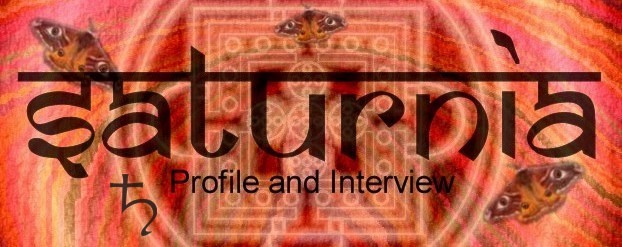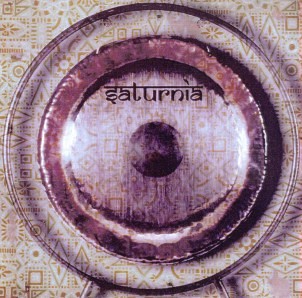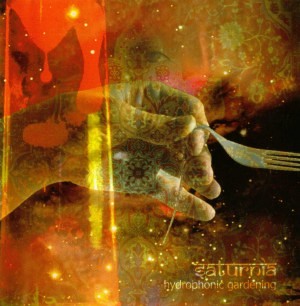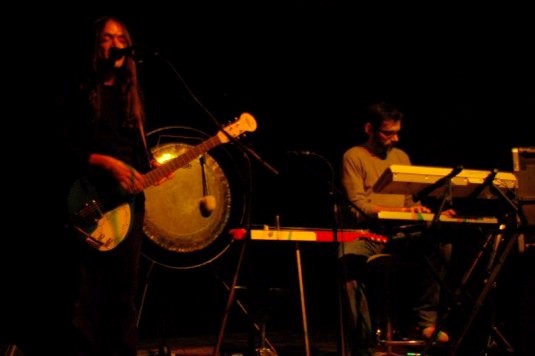

by Jeff Fitzgerald
Band Photograph by Eduardo Vasconcelos from the Saturnia website (used with permission)
Uploaded to Aural Innovations: March 2004
Portugal probably isn’t the first country you think of when you’re looking for spaced out psychedelic music, but it is, nevertheless, home to Saturnia, one of the trippiest head bands playing these days. Here’s a quick overview of their three releases to date, including their latest, Hydrophonic Gardening, followed by an interview with the man and the mind behind the Saturnia curtain, Luis Simões.
 Saturnia - “Saturnia” (self-released, 1999)
Saturnia - “Saturnia” (self-released, 1999)
Saturnia, the brainchild of multi-instrumentalist Luis Simões began with the idea of fusing the classic psychedelic sound of late sixties bands like Pink Floyd and Ash Ra Tempel with their modern trippy counterparts, the artists of the rave and electronica culture. Their self-titled debut blended exotic instruments like sitar and Theremin with more traditional instruments like guitar and organ, and all sorts of wild effects, set to sharp metallic hip-hop and techno rhythms. Simões, joined by M. Strange and guests Flapi Simões and João Gomes create blissed out sonic voyages like the organ and flute driven Club Aquarium and the epic East Indian jam of The Twilight Bong. With its heavily processed vocals, meandering Moog soloing and languid, trip hop beats, Gemini sounds a bit like Portishead on acid. The deep space slide guitars of Iris give it an early Pink Floyd feel until the rapid fire electronic rhythm takes it in completely different directions. And just when you get totally mellowed out, Sculptress Sublime kicks in with its screeching guitars crashing piano notes, juxtaposed against oddly haunting notes that sound like vibes in space.
 Saturnia - “The Glitter Odd” (Cranium Music 2001, CRM 006)
Saturnia - “The Glitter Odd” (Cranium Music 2001, CRM 006)
Saturnia somewhat re-invented themselves for their second release, The Glitter Odd. M. Strange left the band, replaced by Francisco Rebelo, though the driving force behind things remained Luis Simões. Tossing out, for the most part, the hyper-driven electronica rhythms of the first album, the band took a bit more of a traditionalist psychedelic approach this time. There were still upbeat pieces, like the amazing opening track, Chrysalis, but this time the rhythm was more of in more of a grooving style than a dancing style. Other tracks, such as Bliss and Borealis incorporated echo dub-style rhythms into the deeply spacey compositions. They also began exploring otherworldly ambient textures, most notably on the alien jungle atmospherics of A Trick of the Light and the second half of Azimuth/Menadel. Organo even incorporated some lounge organ into the mix, turning the piece into space age bachelor pad music that threw out the martinis in favor of something a little more hallucinogenic. All in all, The Glitter Odd is a much more exploratory album than the debut, with a deeper sound and a definitely mellower approach, as the surrealist space tones of the closing title track definitely summarize.
 Saturnia - “Hydrophonic Gardening” (Mellow Records 2003, MMP 451)
Saturnia - “Hydrophonic Gardening” (Mellow Records 2003, MMP 451)
Taking mellow, psychedelic nature of The Glitter Odd as their cue, Saturnia, still consisting of Simões and Rebelo, create their most lush and organic work today, hence quite appropriately titled Hydrophonic Gardening. The album opens with the title track, a swirling, ever changing ambient excursion, full of watery sounds, deep washes of synths, spaced out echoing slide guitars and murmuring voices. Kozmische Parts 1 and 2 re-introduces a bit of the trip hop rhythms, but in a more subtle way than on the first album. This one manages to both rock and be laidback at the same time, organ and guitar duelling with strange melodies before dipping into a cosmic eastern vibe in the second half, with beautiful mystical Moogs and crazy, freaking Theremin. Sunflower is one of the most beautiful laidback and melodic pieces on the album, with Simões’ voice nicely double-tracked, layered in with some exquisite Mellotron flute. Lava Lamp, as its title would suggest, explores the lounge vibe first tried out on Organa from The Glitter Odd, again with a lovely Moog melody. Planetarium takes the listener into the starry cosmos for a delightfully retro and mysterious space excursion. Vimana is another track with a great, breezy, Eastern vibe to it, and an almost Beatlesque melody. About half the album is devoted to instrumental tracks, the other half to tracks with vocals. This time out, as is particularly evidenced on the final track, Omnia, the vocal melodies are a lot stronger than on previous albums. The overall sound of Hydrophonic Gardening, in fact, is much richer, and more complex, showing Saturnia to be a growing, evolving unit.
I got talking with Luis over e-mail, and we put together this interview, which gives some interesting insights into that growth, from the very different beginnings of the group to what the future holds.
Aural Innovations: The original idea for Saturnia came out of a desire to create “a free art communal project where friends of several artistic professions such as literature, photography, design, painting and of course music, could come and input”. What gave you the idea to start such a project? Had you been involved in anything like this before?
Luis Simões: I thought of this as I was, and still am, very interested in non-musical art forms and their mix with music, particularly those related to image, like film and painting and also poetry. I had done something like that in the early nineties, a project with a friend which consisted of me on guitar, doing mainly effects and he reading poetry. I wanted to do something a bit different than just a band, I thought of Saturnia as a melting pot. All very trippy and unfeasible.
AI: What made the project gradually move mainly into the music spectrum and away from the other arts?
LS: The fact that there had to be a lot of people involved which meant more chaos, also the fact that those artistic areas were not my area and that proved difficult to orchestrate both personally and technically. On the other hand the fact that I had been in bands before and could easily organize something purely musical in a proper way. Naturally the fact that I am a musician also contributed for that. Basically it was a choice between either doing a low budget lo-fi video with music and spoken word or do some solid music.
AI: What is the psychedelic/space music scene in general like in Portugal?
LS: There is no psychedelic/space scene over here. Portugal is a small, old European country with bad musical habits. The whole music scene over here is fairly uninteresting. I don’t really think of Saturnia as a Portuguese band. I see it more as a planetary thing, we are an Internet-era type of group and it is in that context that, I think, we make a lot of sense.
AI: I know it talks a little about this in the promo bio, but for the benefit of readers who haven't seen that, tell me a little bit about how you came up with the name Saturnia. It definitely captures something beautiful, mysterious, exotic and cosmic (hence very appropriate for the kind of music you play!).
LS: Well, finding a name for a band is always one of the most difficult bits due to its importance, after all you are going to be stuck to it forever. I had a very precise notion of the vibe of what Saturnia as a project was supposed to be, so I did the odd list with Filipe Homen, the words that stuck out were Saturn, the planet, with its strong visual identity and saturnalia, synonymous of the word orgy. We sort of blended that and got to the word Saturnia which is a butterfly. It’s a space/cosmic, free pleasure, organic/natural concept encapsulated in a word.

AI: Musically anyway, the original idea of Saturnia was to fuse “psych/prog head music of the seventies with its present day descendant: drug rave culture of drums & bass and jungle”. Are there any artists from either of those eras that you would say exerted a particular influence on you or that you admire in particular (and what about them do you admire)?
LS: Yes, from the old days, Pulsar, Pink Floyd, Hawkwind, the whole German scene (early Tangerine Dream, Ash Ra Tempel etc.) also the big prog names like Genesis or Yes, although to a smaller extent. I always liked these artists because of their utter free creativity, for doing cool music for its own sake. From the more contemporary influences, which are mainly electronic related, I would say Portishead, Alpha and all the English electronic scene from 1990 onwards, what got me into this was the fact that the evasion and freedom that I always loved about the old hippie bands totally disappeared from the “normal” music scene and it somehow landed on the trance/dance/electronic/trip hop etc. sub genre. Maybe due to the fact that both of these movements were strongly related to drugs. To mix these two bubbles was, for me, quite inevitable. I think it is also important not to forget that there are also other styles very influential in the Saturnia sound, I mean, Indian classical music, easy-listening music and also contemporary composers like Luigi Nono.
AI: What are a few of your favourite albums of all time?
LS: That really depends on the time of year, but here are some: Klaus Schulze - Irrlicht, Pink Floyd - A Saucerful of Secrets, Ravi Shankar - India’s Master Musician, Portishead - Live in NYC, Hawkwind - In Search Of Space.
AI: Since Saturnia is primarily your vision, when you create your music, what is going on inside? What are you searching for or trying to express in your music?
LS: Saturnia is mainly about letting yourself go where your imagination takes you. The idea is to harmonize yourself with everything else by flying free for a while. More than an idea, Saturnia is really a vibe. On a more intimate level I am basically trying to feel more acquainted and at ease with my true self through music.
AI: I've noticed that the drum and bass style rhythms are definitely more prominent on your first album then they are on the following releases. Was it a conscious decision to limit that influence, or just a natural progression musically for you?
LS: It just happened. It wasn’t planned. On that first CD the idea was to do the blend between old and new and that’s precisely what happened. It was in that period that the basic guidelines of Saturnia were established; we developed from that. I feel that, rhythm-wise, our music as been moving more and more away from electronica.
AI: Your bio says you practice yoga and meditation. Would you say this has influenced your music and if so, how?
LS: Yes, a lot, although I just want to say, before people start thinking I am some sort of yoga guru or something, that I am a totally careless yoga person; I don’t do it consistently although I should, I am not even a vegetarian. The story of my life is just going from a healthy and not smoking and not drinking yoga state to an unhealthy general abuse rock’n’roll state and back again. Hydrophonic Gardening was done in one of the healthy periods and that reflects on the music as it is very metaphysical and multi-layered and inward meditative. If you check the lyrics of the piece Vimana, it is about the energy of the chakras and the beautiful changes their awakening brings.
AI: One of the key instruments in the Saturnia sound is the sitar. How did you get into playing that? Was it a difficult instrument to learn?
LS: Surprisingly no, I wanted to get a sitar since the eighties as I always loved classical Indian music and the exotic tones of sitars, santoors, veenas and sarangis but it was very difficult to find one over here. In ‘96, at a handicraft exhibition, I spotted one and bought it and in two days I was already playing it. It really felt very natural just as if I had been doing it for ages. In essence, the sitar is an Indian guitar and in what refers to their musical logical mechanics both instruments are sort of similar. It is just the size, feel, touch and musical organization of the instrument itself that are very different. I stopped using the Indian sitar live because it is very fragile and very sensitive to temperature changes. I’ve been using an electric sitar instead which is an hybrid between a sitar and an electric guitar. I also like sitar psychedelia like The Beatles and sitar easy listening grooves like Lord Sitar or the Vampyros Lesbos soundtrack.
AI: Have you actually studied eastern music, or have you more tried to apply the use of an eastern instrument to western styles?
LS: I learned from books and from information I got from the Internet, what I have always done was to apply it to Saturnia. I think all musical instruments only make sense in a musical framework, that is their “raison d’etre”; by themselves they are only sound producing machines that musicians are fetishistic about. I am much more into music than into instruments.
AI: You also champion the Theremin. What got you into that unusual instrument? Did you buy a Theremin, or build your own?
LS: What first got me into the Theremin was the rather unusual concept of the instrument itself, I mean, how can you not be in love with an instrument you don’t touch while you are playing it?! Being a sci-fi freak also got me into the Theremin, used in film soundtracks such as Forbidden Planet, but it was after listening to Clara Rockmore playing The Swan that I realized it was a serious instrument and not some nice electronic curiosity. I bought mine at Macaris in London.
AI: I'm just curious... there is something that sounds like flute in a lot of your tracks, but there is no flute listed as being played on your albums. What instrument is producing that sound?
LS: Apart from the first Saturnia CD which features real flutes on both Club Aquarium, by Flapi Simões and The Twilight Bong, by myself, all the flutes you have on The Glitter Odd and Hydrophonic Gardening are from a keyboard instrument from the sixties called Mellotron.
The Mellotron works as a mechanical (rather than digital) sampler as it reads tapes with previously recorded instruments such as violins or flutes. A friend of mine had a more or less ok working Mellotron that he kept in my place for sometime; I used it a lot and sampled it, it was unreliable, it went out of tune and didn’t work properly quite oftenly. We have always used Mellotron samples live for portability sake. We have other vintage gear like the Phillicorda organ that we use for rehearsals and recording only.
AI: I noticed on the “things we like” section of your promo disc a few interesting pictures. One was of Stonehenge. Have you visited there, and if so, what was your experience?
LS: Yes, I have been there once as a tourist. It is a very powerful spot. I know this is a bit of a head music cliché but I am very interested in the unknown, mythical past of mankind; so stone age constructions, pyramids, the Bermuda triangle, Easter island, vimanas and that kind of subject interests me immensely. There are some cromlechs over here in southern Europe.
I think mankind must get much more acquainted with its spiritual present and past and leave the science god in its place. Don’t get me wrong, as you may imagine, I am really into technology but that must be an extension, not the basis.
AI: Another was something from the cover of the soundtrack to Vampyros Lesbos. Has this had an influence on your music?
LS: As I told you before I am into that type of seventies kitsch thing. What made Vampyros Lesbos stand out for me, was Soledad Miranda who was married to this Portuguese car racer also called Simões. Soledad is really my visual notion of an extremely sexy woman, and I am very keen on that vibe of those totally “naïf” films in which people take their clothes off in a “groovy” way.
AI: On The Glitter Odd, I'm sure I hear the sound of a needle dropping on a record at the beginning and being taken off at the end, as well a little bit of surface noise. As far as I know, there was no vinyl release of that album. Was that an intentional nod towards the classic format of the vinyl LP? Would you call yourself a vinyl junkie?
LS: Yes it was quite intentional to have the CD looking and sounding like a vinyl. Not a lot of people know this but The Glitter Odd is a loose concept album. It doesn’t have a story or a chronology or even a musical ongoing theme, it just goes around the idea of a person staying in his/her bedroom listening to an old LP, which is something i do a lot. Also the wallpaper that you have on the cover is my bedroom’s 70’s old wallpaper, so that kind of tied up the whole thing together for us. It is a bit of a private concept, a very light thing.
I wouldn’t call myself a vinyl junkie, but I really like the format. The sound is so much larger. Both me and Francisco have considerably large vinyl collections. It was Vasco, who played keyboards before Francisco, that really was a vinyl junkie, he wouldn’t buy a CD unless he would have to. A nice guy.
AI: Like other head music, the studio is obviously an important tool in creating your recordings. What are some of the challenges of then playing this music live, especially with only two musicians? What are the differences in your approach to recording in the studio and playing the music live?
LS: Live performance and studio are very different dimensions of the very same thing; in the studio we feel that the requirements are only of an artistic and creative nature so we just don’t let anything come in-between us and our goals, so we’ll have more keyboard and guitar tracks than just two guys can play simultaneously; total freedom and promiscuous imagination are the rule. Our music comes mainly out of improvisations that get slowly organized and reworked but the basis is always beats with keyboards, guitar/sitar and vocals, which is what we do live. For gigs we have all the rhythms and essential bass lines sequenced and we’ll play organ, synthesizer, guitar, lap steel, electric sitar, theremin, gong and voice on top of that. Some people feel rather uncomfortable that a band that sounds like us is just two guys onstage but, for instance, the kind of rhythmic thing we do, couldn’t be done by a drummer. Of course there are also logistical decisions in this area, it would be great to have a symphonic orchestra at our command but it just isn’t feasible. In Saturnia, like I told you before, regarding the Mellotron and the organs, portability and budget are of the essence.
AI: Your latest album, Hydrophonic Gardening, I think is your best to date. It has an even deeper, more lusher feel than previous albums. Did you take a different approach to recording it, or would you say the difference is more a compositional one?
LS: This time we went through the recording process more thoroughly, we really took our time, we patiently tried everything we reminded of and explored every idea, sound and musical section to its ultimate consequences, I think that reflects on the whole of the album as it is probably the most mature and solid thing we did this far. I think some of its lusher deeper feel is also a consequence of the meditative peaceful state I was in at the period. Again, much more than the quite tangible aspects of compositional structures, chords or scales, which, in this CD, are not really a departure from, say, The Glitter Odd, I feel it is much more the mood that really makes Hydrophonic Gardening what it is.
AI: Francisco Rebelo returns on Hydrophonic Gardening. Is there a difference in his role now in Saturnia than before. Would you say this is more of a group effort, or does it remain primarily your vision?
LS: Unfortunately if I’d say Saturnia was teamwork I wouldn’t be completely true. Although Saturnia is primarily my vision and a very special thing to me, that doesn’t mean at all I am not into cooperation, very much the opposite, if there are five people in the world that I know of, that I would let and want them to have input on Saturnia, Francisco is definitely one of them. He is a real pro musician, an awesome bass player, a great keyboardist and he can also sing. Regrettably he has his own musical life, with its own problems and agenda and thus far Saturnia has been a breathing space for him to come in and just play and jam. Still, his arrival to Saturnia in 2000 has made a real difference in terms of vibe and perspective for myself. It is curious that you make this question as I am really pressing him to be a much more active part of Saturnia and I am really trying to have much more of him in the next album as I feel that would greatly enrich the final result.
AI: What's next in the works for Saturnia?
LS: Well, we are currently working on what will be the next Saturnia CD and that is totally absorbing us, it would be lovely to have it finished by early summer, but it still is a bit early to say. We have been playing some shows over here and will play a couple more later on this year. I am also trying to get us playing outside of Portugal but that is still a big unknown right now. So its business as usual for us: play live, a new album and try to promote the band as much as we can.
For more info, check out the Saturnia web site at: http://saturnia.cjb.net
Or write Luis directly at: saturnia@mail.telepac.pt